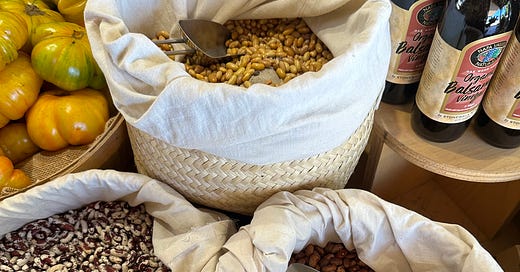Comfort is a pot of homemade beans. I love the procedure of cooking a big pot of dried beans any time of year but especially as the weather cools and I want to be cozy. It feels like grandma-style cooking. Simple, nearly austere. Perfect for a Sunday project to enjoy throughout the week and don‘t get me started about the bean broth. You can use it anywhere you’d use vegetable or chicken stock. It’s thick and somehow creamy. Definitely don’t discard it.
Here’s how I do it:
First, I am team soaked beans. Some people don’t, and in a pinch you don’t have to, but I find even 2-6 hours of soaking yields a more evenly cooked result, not to mention the cook time. Soaked beans cook faster and there is an inverse relationship between soaking and cooking time. The other reason I soak my beans prior to cooking is for the opportunity to infuse some flavor by seasoning the soaking water with salt. I add about as much salt as I would for cooking pasta - so about 2 tablespoons for 1 pound of dried beans. Common advice is to not salt your beans until they soften (otherwise they don’t cook properly), but this only flavors the liquid, not the beans themselves. After many many pots of beans and soaking experiments, I’ve found that a brined soaking situation flavors the beans themselves well and doesn’t compromise the texture.
I dump the beans in my dutch oven and cover with 1-2 inches of water plus 2 tablespoons of kosher salt and soak them for at least 2 or up to 24 hours. Some varieties need a longer soak (chickpeas) and thinner skinned small varieties like black beans don’t need as much time. Older beans need a longer soak and cook. I always source high quality beans and don’t let them linger long in the pantry. Rancho Gordo is my favorite.
Once I’m ready to cook, I chop up an onion into large chunks (about 2 inch pieces) and peel an entire head of garlic cloves. I snip the stem from a dried chile (usually a guajillo or Calabrian chile). I run to the garden and snip some herbs (oregano for black or pinto beans, or parsley and thyme for a cranberry or cannelini beans).
Drain the beans and rinse out the dutch oven. Warm 2 tablespoons of olive oil over medium high heat and add the onions and garlic to the pan. Saute until it smells great and the onions are beginning to take on some color, about 8 minutes.
Add the drained beans to the pot with the onions and garlic. Pour in enough water to cover by 2 inches. Add in the fresh herbs, and 4 dried or 2 fresh bay leaves. Drizzle in 1 tablespoon of olive oil. Return the pot to high heat and bring to a boil. Once the beans boil for a minute, reduce the heat to a lazy, bare simmer. You can use the lid to modulate the heat (aka partially cover the pot to encourage a simmer) but I usually don’t use a lid. No lid = more evaporation = better broth. Cook until the beans are tender but not falling apart. We can’t accurately say how long this will take (I don’t know how old your beans are and neither do you) but I would recommend that you start checking soaked beans as early as 40 minutes into simmering. It can take anywhere from 1-3 hours for your beans to cook, again depending on their age. I find that high quality or local beans cook faster (because they are fresher). Again, it’s really about the age of your beans. I made a pot of lentils the other day (notoriously quick cooking legume) that had been languishing in the back of the pantry and it took nearly 3 hours. So you never know.
When the beans are done, let them come to room temperature in the pot before storing them (in their broth) in the refrigerator. Or, whip up a pot of brothy beans. Toast some panko in a saute pan in olive oil until golden. Transfer to a plate and season with salt and freshly ground pepper. When the beans are done, wilt a handful of greens (I like baby kale) into the broth. Divide the beans and greens between shallow bowls. Season to taste with salt and lemon juice or preserved lemon liquid. Top with the panko and shaved parmesan and dig in.




